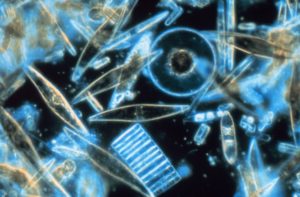Citation: Sutherland, K. M., Wankel, S. D., & Hansel, C. M. (2020). Dark biological superoxide production as a significant flux and sink of marine dissolved oxygen. PNAS, 117(7), 3433-3439. https://doi.org/10.1073/pnas.1912313117
[hr]
Many marine microbes (as well as humans) need oxygen to survive, but a byproduct of oxygen consumption – superoxide – can wreak havoc on living organisms. In spite of this fact, scientists have discovered several beneficial uses for superoxide, and now estimate that up to one-fifth of the ocean’s oxygen is spent on producing this mischievous (and misunderstood) molecule.
What is Superoxide?

Superoxide (O2–, Figure 1) is a compound that forms when a single, unpaired electron grabs ahold of oxygen gas (O2) in a process called reduction. (“Reduction” because the charge of oxygen is reduced by adding an electron.) The unpaired electron can damage living cells, making superoxide toxic at high concentrations. But despite its toxicity, nearly all animals and plants on Earth – as well as many marine microbes – make superoxide, because it’s a necessary byproduct of oxygen reduction to water. An enzyme called superoxide dismutase helps us break down excess superoxide before it can do any damage. And traditionally, superoxide has only been seen as evil – a compound to just get rid of.
However, recent investigations have suggested that superoxide functions in a lot of beneficial ways when exported outside the cell. In certain plants, for example, it may help repair wounds. In marine microbes, it’s thought to regulate growth rate, and in corals, it may be an indication of stress. With these new ideas in mind, scientists from the Woods Hole Oceanographic Institution in Massachusetts set out to measure the extent of superoxide’s role in the ocean – and more specifically, its global production rate.
Measuring Superoxide Concentrations

To do this, the scientists measured superoxide production rates for individual marine microbes in the lab. They examined “photosynthetic” microbes, which make their energy from sunlight; “heterotrophic” microbes, which make their energy from organic material; and photosynthetic algae (Figure 2). Each species was grown in a separate culture until it reached its exponential growth phase – the point at which it was growing fastest. The scientists then injected a luminescent chemical into the culture, which reacted with superoxide to create a light signal. The strength of this signal allowed the scientists to measure the amount of superoxide produced by each marine microbe over time (Figure 3). In general, rates for photosynthetic microbes and algae far exceeded those of non-photosynthetic bacteria, though superoxide production appears to be very species-specific.
By combining the superoxide production rates of each group with previous estimates of its abundance in the ocean, the scientists were able to calculate a global rate of superoxide production – 3.9 x 10^15 moles/year. But what does this number mean exactly, and why is it important?

An Underrated Role in the Marine Oxygen Cycle
In the marine oxygen cycle, there are both sources and sinks. The major source of oxygen is photosynthesis, which produces 1.09 x 10^16 moles/year. Marine scientists have long assumed that the major sinks are respiration and photorespiration – respiration that occurs in some photosynthesizers – because so many ocean organisms respire oxygen for energy. (A few examples are whales, fish, krill, and many marine microbes.) But if the superoxide sink was measured at 3.9 x 10^15 moles/year, superoxide production alone takes up 36% of the oxygen.
Most of the superoxide produced gets quickly recycled back to oxygen, so the authors estimate that the net ocean oxygen sink via superoxide production is only 6-18% of marine photosynthesis, rather than 36%. But this is still an enormous, previously unaccounted-for amount of lost oxygen. And this estimate only took into account the superoxide produced by a few major microbial groups!
The authors argue that as a result of their work, rates of respiration and photorespiration in the ocean are probably far lower than we’ve previously estimated. And their findings also highlight how prolific superoxide is in the marine environment. Clearly, there’s much we still don’t know about this complex and misunderstood molecule.
I’m a PhD candidate in Earth System Science at Stanford University, and I study how microbes in deep ocean sediments produce and consume greenhouse gases. I’m a native of the landlocked state of Minnesota, so I’ve always been fascinated by the ocean. When I’m not in the lab, I love to race triathlons, forward “The Onion” articles to friends and family, and hike with my hound dog Banjo.

